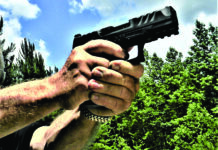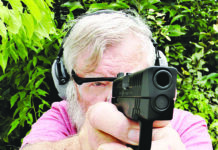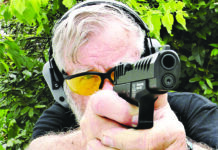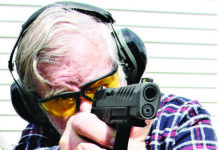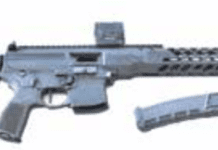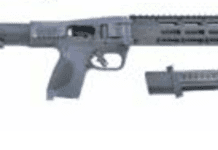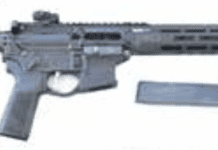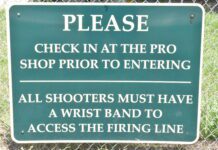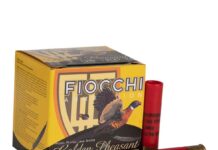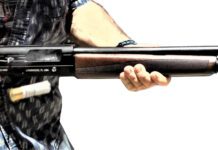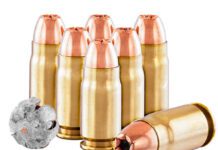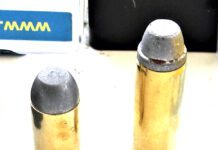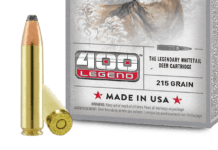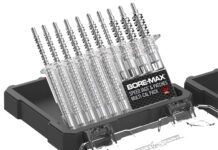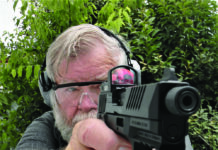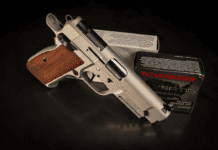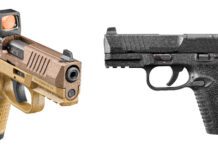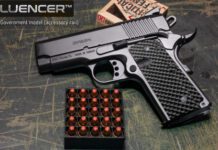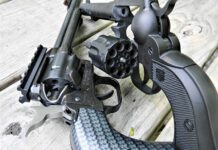Light .38 Special Self-Defense Loads: We Pick Remington
The .38 Special continues to be one of the most popular revolver cartridges in production, in part because the load can be made hotter with higher-pressure +P loads, but also because it can still do a viable job of self-defense, even when loaded for standard pressures.
But one additional area of .38 Special performance is our focus here: lower-pressure, lower-recoil ammunition. Because the .38 has been popular for decades, there are many older revolvers which can't shoot higher-pressure +P loads (consult your gunsmith) safely. Also, there are many Gun Tests readers with new .38 Special or .357 Magnum revolvers who are very recoil conscious, and who might prefer a .38 round with softer recoil.
We decided to see if the lightest commercially loaded .38 Special rounds met our self-defense standards, and we added in a couple of handloads to take it down another notch or two.
Big-Bore Revolvers: For Power, Choose Rugers Super Redhawk
In this article we evaluate three guns that make no excuses for their girth. The Smith & Wesson Model 21-4 is a straightforward, large-frame revolver chambered for .44 Special only. Its .45 Colt brother, the Smith & Wesson Model 25-13, is slightly more modern, adding adjustable sights. The Ruger Super Redhawk Alaskan was fit with a longer cylinder, and together with its heavy frame, it is capable of firing .454 Casull as well as .45 Colt ammunition.
Our focus in this test was personal defense from humans and not bears, so we left the Casull rounds at home, but we did test an extra-heavy .45 Colt load from Atlanta Arms and Ammo formulated specifically for Ruger and Thompson Center firearms (
For our .44 Special rounds we chose 165-grain JHP rounds from Cor-Bon, Winchester's 200-grain Silvertip HP rounds, and 240-grain Truncated Cone Jacketed ammunition manufactured by Atlanta Arms and Ammo. Test distance was 25 yards from a sandbag rest. We fired single action only to collect hard data, but fired on steel targets double action only to evaluate rapid-fire capability. Limited to six-round capacity, we wanted to know which guns offered the right mix of power, accuracy, and speed. Here's what we learned:
Four 9mm Heavy Hollowpoints: We Would Buy Speers Gold Dot
The 9mm cartridge has been around for over 100 years. NATO has chosen it as its standard pistol round, and the U.S. military has been using it for many years in its standard-issue Beretta M9s. Although we at Gun Tests tend to favor the .45 ACP cartridge, the 9mm round has its advantages. It can be chambered in smaller, lighter, and more concealable pistols, such as the recently tested Kahr PM9, than the .45 round can. It is also more affordable and has substantially lower recoil than many other pistol cartridges. Although the 9mm Luger is only 2mm longer than the .380 ACP, also known as the 9mm Kurtz and 9mm short, it has substantially higher pressure and can handle bullets that weigh more than 1.5 times than the .380.
Because of the 9mm's near-universal appeal, we wanted to test a sample of hollowpoint cartridges in the popular 147-grain weight class. Into our test gun, a Smith & Wesson Model 39-2, we fed four self defense-appropriate 9mm hollowpoint loads: Speer's 147-grain Gold Dot GDHP (Load No. 23619, Gold Dot Hollow Point); the Remington 147-grain Golden Saber Brass JHP (Load No. GS9MMC, Jacketed Hollow Point), Winchester's 147-grain SXT (Load No. S9, Supreme T-Series Jacketed Hollow Point), and Federal's 147-grain Hydra-Shok JHP (Load No. P9HS2, Jacketed Hollow Point).
Shoppers can find these rounds for comparable prices, usually within 3 cents a round of each other. We shopped Midway USA
We selected the Smith & Wesson Model 39-2 for our test gun. The model 39 was the first U.S.-designed 9mm double-action semi-automatic pistol, first available to the public in 1955. It has been used by the U.S. military, and the older steel-frame models are especially valuable. Our 39-2 had a lightweight alloy frame and was made in the 1970s, but we bought it secondhand about 10 years ago. At the time of testing, we had already fired approximately 1200 rounds through the gun, so it was thoroughly broken in and suitable as a self-defense choice.
Budget .45 Colt Cowboy Guns: Heritage Comes Up Shooting
According to a number of online dictionaries, there is no definition listed for the term, "cowboy gun." Nevertheless, the popularity of revolvers descending from the Colt Single Action Army has brought new meaning to these words. Since 1999 we have tested at least 18 different handguns that fit what we define as a cowboy gun, and now there are two more entering the market.
The Taurus Gaucho No. SA45B, $499, and the Heritage Manufacturing Big Bore Rough Rider No. RR45B5, $379, are six-shot single-action revolvers each with 5.5-inch barrels and chambered for 45 Colt. Some refer to this 1.6-inch-long straight-walled case with a 0.454-inch diameter bullet as .45 Long Colt, but in either case this caliber did not actually exist in the 19th Century. What is important is that these guns are for pleasure first, and they do not come with big price tags.
But their budget prices don't mean we're going to let them off the hook should they prove wanting in one area or another. Physically, the Gaucho and the Rough Rider could not be closer. Indeed, since they are replica guns, any variation from form, whether a positive innovation or not, would more than likely spoil their appeal. Both guns are dark-blued steel. Both guns have a tall front sight and a rear sighting notch exposed when the hammer is pulled back. Sight radius was equal. Each gun cylinder rotated clockwise, and with the loading gate open, the cylinders clicked with the indexing of each chamber. Ejector-rod movement was approximately 2.7 inches for each gun. The hammers on each gun lacked firing pins, using instead a transfer-bar system for greater safety. The Gaucho featured a plastic grip, but the grip on the Rough Rider was wood. The shape of the bell-shaped grips each started with a wide base that tapered to a 4.1-inch neck. Their weight, size, front strap and back strap height were nearly identical.
With so little to distinguish the two guns, our main concerns in this test were accuracy, fit, and function. Our test distance was 25 yards from a sandbag rest with four different choices of ammunition, two modern and two others sold in boxes decorated with Old West graphics. The modern rounds were Winchester's 225-grain Silvertip hollowpoints and Remington's 225-grain lead semi-wadcutters. The remaining ammunition brands, likely being marketed to Cowboy Action shooters, were 250-grain lead flat-point rounds from PMC and Black Hills Ammunition. We also looked back at other .45 Colt cowboy guns we have tested to see how these two newcomers stacked up within the category overall.
.45 Auto Frangible Loads: Our Pick Is Winchester Ranger
Self-Defense .38 Spl. +P Loads: Our Pick Is Winchesters SXT
Our tests of commercially available .38+P revolver cartridges from Federal, Winchester, and Remington show good to acceptable accuracy results and very manageable recoil.
9mm +P and +P+ Cartridges: Winchester & Remington Win
These rounds should have more pop than standard-pressure 9mm Parabellum cartridges, and in three cases we found that to be true — the winners shoot on par with .357 Magnums.
Self-Defense .45 GAP Loads: None Have Everything We Want
Our tests of commercially available Glock Automatic Pistol cartridges from Federal, Winchester, and Speer show disappointing accuracy results and stout recoil.
Survivor Bullet Testing: .45 ACP 230-Grain Hollowpoints
We believe our tests of cartridges from Federal, Winchester, PMC, and Speer can point you toward a topnotch self-defense ammo that you can, and should, evaluate in your own handgun.
Shotguns, Slugs, Buckshot: Whats Right for Effective Self-Defense?
We test several loads in an affordable pump gun and learn when enough power is enough and when a lot of power is too much.
Polymer-Cased .223 Rem. AR-15 Ammo: Fantastic, or Just Plastic?
Traditionalists may recoil from shoving plastic into their chambers, but this product was safe, reliable, and accurate.
Winchester Ranger Ammunition Challenges Federal Hydra-Shok
The Ranger Law Enforcement Only (LEO) ammunition is a direct challenge to the Federal Hydra-Shok cartridge that is used exclusively by the FBI. We wondered how the two rounds stacked up in a head-to-head comparison, so we acquired samples of both rounds in .357 Sig, .45 ACP and .40 S&W [PDFCAP(1)]. Here is what we found.
The Winchester Ranger ammunition in .357 SIG (125-grain SXT, code RA357SIGT, a jacketed hollowpoint) on average fell some 27 foot-pounds of energy short of the Federal Hydra-Shok in the same weight and configuration. Accuracy of the Ranger round was also slightly behind, to the tune of 0.3 inch on average. Other considerations, recoil and report, were slightly less than when firing the Federal cartridge in the SIGArms P239.
On the .40 S&W side, the Winchester Ranger cartridge, we feel, proved superior when fired in the Glock 22. The Ranger 180-grain SXT (code RA40T) shot groups nearly half the size of the Federal Hydra-Shoks in the same bullet weight and configuration. Muzzle energy was nearly identical but recoil and report were, in the case of the Ranger ammunition, noticeably reduced.


